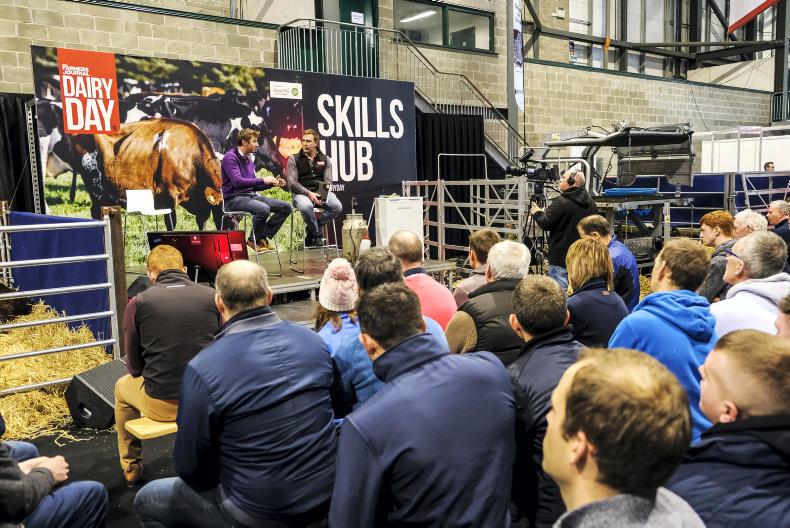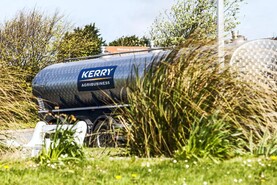Over 5,000 farmers passed the doors to this year’s event – making it the largest crowd ever at Dairy Day. Alongside the 80 trade strands, there were three stages. On the Beyond the Parlour stage, Jack Kennedy put international speakers John Yu from China, Cristian Swett from Chile, Gisbert Kuegler from Germany and John Penno from New Zealand through their paces.
At the Skills Hub, Aidan Brennan outlined what he feels is a hassle-free way of calf rearing. He highlighted the need for adequate facilities, both for calving cows and for rearing calves.
“It all depends on your calving rate. We know the target is to calve 90% in six weeks and many farmers are achieving this now, but it’s not linear. In most cases, 50% of the herd calves in the first two or three weeks. When you work it out, a farmer with a compact-calving herd needs to have 70 calf spaces per 100 cows in the herd and that’s presuming bull calves are sold at two weeks of age,” Aidan said.

This year’s Dairy Day was the largest ever, with more than 5,000 in attendance. \ Philip Doyle
Training
He said the less time the newborn calf spends with the cow the better, both from a health point of view but also as an aid to training the calf to suck from a teat. Aidan criticised the use of individual calf pens for baby calves. “They actually make work. Every calf has to be fed on its own and they’re hard to get in and out of. Plus, they’re made from steel, which radiates the cold and they’re hard to clean out. I think they’re a disaster. It’s better to put baby calves in small groups of three or four. It’s as difficult or as easy to train three calves to drink as it is to train one. More often than not, it’s easier to train a few calves together.”
As soon as the baby calves are sucking well, he recommends that they are kept in groups of nine and trained to a 10 teat feeder until they are 10 or 14 days old and strong enough to join a bigger group.
“Big pens reduce the workload dramatically. I’ve seen calves penned in groups of up to 40 and it works very well, but you need to have an efficient way of feeding them.
“At that number, it’s either a tow-behind feeder with 40 or 50 teats or an automatic calf feeder with two feed stations. Both dramatically reduce workload but they have their drawbacks.
“It can be hard to remove the tow-behind feeder from the pen as the calves tend to follow it. Some farmers make special gates so the feeder can be backed in without the calves getting out.
“The drawback with the automatic calf feeder is the high cost and the fact that they are best suited to just feeding milk replacer, whereas there is usually a lot of waste milk around in spring and it’s a shame not to use this,” Aidan said.

Aidan Brennan and Shane Horgan at Dairy Day 2019. \ Philip Doyle
He said that once-a-day milk feeding is allowed from four weeks of age, but he said he knows of farmers who start sooner and have good outcomes. On the quantity of milk to be fed, he said farmers need to look into research claims;
“There’s lots of published data out there from reputable research centres to say that the more milk you feed to a calf, the more milk she will produce as a cow. But you need to ask what system this research is based on.
“It is usually from the US or other year-round calving systems where they have found that heifers that calve at less than 22 months of age have higher lifetime production than those that calve over 24 months. In our block-calving system, we don’t want heifers calving at less than 22 months of age, so all of this extra feeding is costly and unnecessary.”
He also quoted the latest results from the Grange calf-to-beef study, which shows that the calves fed four litres of milk replacer per day have similar liveweight now to the ones that were fed eight litres of milk replacer per day. There was €33/calf difference in feed costs between the two treatments.
Read more
Dairy - what has changed in 2019?
Screen-addicted children driving China’s dairy consumption
Over 5,000 farmers passed the doors to this year’s event – making it the largest crowd ever at Dairy Day. Alongside the 80 trade strands, there were three stages. On the Beyond the Parlour stage, Jack Kennedy put international speakers John Yu from China, Cristian Swett from Chile, Gisbert Kuegler from Germany and John Penno from New Zealand through their paces.
At the Skills Hub, Aidan Brennan outlined what he feels is a hassle-free way of calf rearing. He highlighted the need for adequate facilities, both for calving cows and for rearing calves.
“It all depends on your calving rate. We know the target is to calve 90% in six weeks and many farmers are achieving this now, but it’s not linear. In most cases, 50% of the herd calves in the first two or three weeks. When you work it out, a farmer with a compact-calving herd needs to have 70 calf spaces per 100 cows in the herd and that’s presuming bull calves are sold at two weeks of age,” Aidan said.

This year’s Dairy Day was the largest ever, with more than 5,000 in attendance. \ Philip Doyle
Training
He said the less time the newborn calf spends with the cow the better, both from a health point of view but also as an aid to training the calf to suck from a teat. Aidan criticised the use of individual calf pens for baby calves. “They actually make work. Every calf has to be fed on its own and they’re hard to get in and out of. Plus, they’re made from steel, which radiates the cold and they’re hard to clean out. I think they’re a disaster. It’s better to put baby calves in small groups of three or four. It’s as difficult or as easy to train three calves to drink as it is to train one. More often than not, it’s easier to train a few calves together.”
As soon as the baby calves are sucking well, he recommends that they are kept in groups of nine and trained to a 10 teat feeder until they are 10 or 14 days old and strong enough to join a bigger group.
“Big pens reduce the workload dramatically. I’ve seen calves penned in groups of up to 40 and it works very well, but you need to have an efficient way of feeding them.
“At that number, it’s either a tow-behind feeder with 40 or 50 teats or an automatic calf feeder with two feed stations. Both dramatically reduce workload but they have their drawbacks.
“It can be hard to remove the tow-behind feeder from the pen as the calves tend to follow it. Some farmers make special gates so the feeder can be backed in without the calves getting out.
“The drawback with the automatic calf feeder is the high cost and the fact that they are best suited to just feeding milk replacer, whereas there is usually a lot of waste milk around in spring and it’s a shame not to use this,” Aidan said.

Aidan Brennan and Shane Horgan at Dairy Day 2019. \ Philip Doyle
He said that once-a-day milk feeding is allowed from four weeks of age, but he said he knows of farmers who start sooner and have good outcomes. On the quantity of milk to be fed, he said farmers need to look into research claims;
“There’s lots of published data out there from reputable research centres to say that the more milk you feed to a calf, the more milk she will produce as a cow. But you need to ask what system this research is based on.
“It is usually from the US or other year-round calving systems where they have found that heifers that calve at less than 22 months of age have higher lifetime production than those that calve over 24 months. In our block-calving system, we don’t want heifers calving at less than 22 months of age, so all of this extra feeding is costly and unnecessary.”
He also quoted the latest results from the Grange calf-to-beef study, which shows that the calves fed four litres of milk replacer per day have similar liveweight now to the ones that were fed eight litres of milk replacer per day. There was €33/calf difference in feed costs between the two treatments.
Read more
Dairy - what has changed in 2019?
Screen-addicted children driving China’s dairy consumption








 This is a subscriber-only article
This is a subscriber-only article









SHARING OPTIONS: